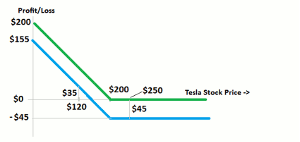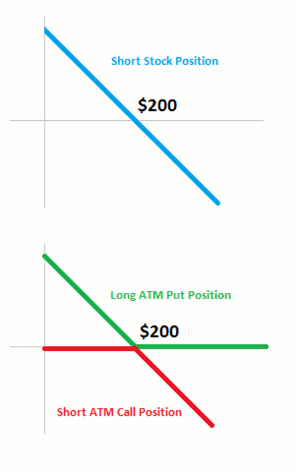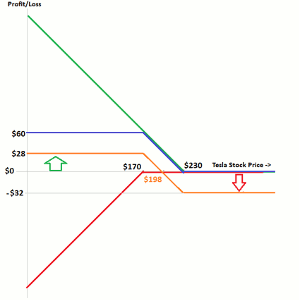Since this volatile stock is currently a costly buy, Shobhit Seth, at Investopedia.com, offers several ways for investors to gain exposure through low cost options contracts, though he cautions traders to take care to understand the drawbacks, limitations, etc. before taking a bet in the real-world options market.
Tesla Motors, Inc. (TSLA), presently trading for about $260 a share, is a costly buy for small investors. In this article, we will provide basic business analysis and dependency factors for the electric car maker before exploring how investors can gain exposure to Tesla through low cost options contracts.
A Brief Intro to Tesla Motors
With a current market cap of $33.18 billion, the NASDAQ-listed, Palo Alto, CA-based Tesla designs, develops, manufactures, and sells electric vehicles. It does this with its own dedicated sales and services channel. In addition, it also produces electric motors, gearboxes, auto components, and lithium-ion battery packs. Tesla is also a major player in building the infrastructure to support all-electric cars. It has built 448 Supercharger stations (with more planned) spread throughout the USA. They offer quick and free charging for Tesla vehicles.
Dependencies for Tesla Motors:
Falling oil prices may severely reduce the demand for electric cars. This could be compounded by a strong US dollar damaging export revenues.
Recent reports of falling exports to China, the world’s largest auto market, due to lower sales of electric cars, indicate a global decline in electric car demand. Tesla had already revised its annual global sales target of 35,000 cars down to 33,000 cars and there are apprehensions that this too may be unachievable.
Competition in the electric car space—BMW and VW are joining hands to build a network of charging stations across the United States similar to Tesla’s—may impact Tesla negatively. However, it also affirms a positive outlook for electric cars in the long run. Overall, this would be positive for Tesla’s business.
Other related reports indicate a better outlook: Tesla is targeting over 300 new stores across the globe, including 100 in China, by the end of 2016. There are target cuts by brokerage firms and research houses, but the cuts aren’t that big (like an earlier target of $300 pushed to $290). Analysts remain bullish on Tesla, claiming that its long-term fundamentals are strong and that temporary declines in sales can be attributed to industry-wide global factors.
Current State of Tesla Stock
Considering the above factors, Tesla is expected to remain a highly volatile stock with investors balancing on either side with bullish and bearish views. Such high volatility makes it ideal for trading.
Common investors often miss out on the action with high-priced stocks because they are scared off by prices.
Limited knowledge may often lead to a perception of the stock being too costly and overvalued with no more room for further price appreciation.
While the last point remains dependent on individual perception, the dependencies in the first two can be circumvented by trading Tesla through option contracts and combinations which offer easy, low-cost alternatives to trade in Tesla.
NEXT PAGE: The Option Combinations and the Benefits
How to Trade Tesla Using Low-Cost Option Contracts
For any trade, one needs to take a directional view for a predetermined time frame of investment. Tesla options are available for up to two-year-long expiry on NASDAQ.
Tesla Options
Let’s assume that trader has a two-year-long investment period for Tesla with a bearish view (in other words, expecting Tesla's stock price will decline). Here are a few option strategies which can be accomplished with low cost.
As a base case for comparison, assume that Tesla stock is available for $200 (January 2015) and a trader with bearish view has a target of $120 (40% profit) and stop loss level of $250 (25% loss).
Buy a ATM Put: The long put option with strike price $200 and expiry January 2017 is available for $45.
If the trader’s target of $120 is achieved, he will profit by (put strike price – underlying – put premium) = $200-$120-$45 = $35 (subject to brokerage charges). On an invested amount of $45, his net profit of $35 translates to 77.78%, much higher than the 40% available through stock purchase. However, the downside is proportional. If the trader’s bet on the direction goes wrong and Tesla stock price hits his stop loss level of $250, he will lose all his invested amount of $45 (a 100% loss, which is much worse than a 25% loss in stock trade).
- Green Graph—Put option payoff without price consideration
- Blue Graph—Put option with $45 premium paid, indicating profit and loss at levels of $120 and $250.
Let’s see the next option to improve on profits.
Replicate Exact Short Stock Payoff: Shorting an ATM call (assuming premium $50) and going long on ATM put (costing $45) provides similar payoff to stock.
The added benefit is that this combination provides net $5 receivable ($50 from short call and $45 paid for long put) making it a net credit position. However, a short call will require margin money. Even if the entire trading capital (say $200) goes towards margin money, the net $5 credit will enable a sufficient number of such positions to be created (say 5), still giving a $25 credit. Checking at target ($120) and stop loss ($250) levels against available $200 capital, the profit percentage is 200% ($80*5 = $400 on $200) and loss, 125% ($50*5 = $250 on $200). This combination has improved the profit percentage, but also increased the risk due to higher loss. This strategy suits the traders with high-risk and high-return expectations.
Let’s see the next position for a more balanced approach.
NEXT PAGE: The Bear Put Spread, the Volatility, and the Bottom Line
|pagebreak|Bear Put Spread: Assuming the trader has a bearish view and moderate risk appetite. He has limited profit expectations and loss taking levels, both around $30. A bear put spread can fit with a long put ($230 strike price assuming cost $64) and short put ($170 strike price costing $32). The net payable amount is $32.
- Green Graph—Long put option with strike price $230
- Red Graph—Short put option with strike price $170
- Blue Graph—Net position of the above two (summation of green and red) without price considered
- Orange Graph—Final net position with price of $32 payable included (blue graph shifted down by $32)
As observed from orange graph, the maximum loss is limited to $32 (if Tesla stock goes above $230) and the maximum profit is limited to $28 (if Tesla goes below $170). From $170 and $230, the profit decreases in a linear fashion converting to loss at $198 and higher. This is a limited profit, limited loss scenario.
All the above-mentioned positions or combinations can be modified according to the trader’s choice and trade strategy. Strategies could include moving from ATM to OTM or ITM options or changing the spread interval.
On the contrary, if the trader has a bullish view, the same positions can be replicated for the upside with a long ATM call, exact long stock payoff with long ATM call and short ATM put, and bull call spread, respectively.
Play the volatility: Volatile stocks like Tesla offer another aspect of trading opportunity through options. Volatility is an important and dominant factor in option valuation. Higher volatility leads to higher option premiums. Experienced option traders can explore trading Tesla options accordingly, going short of call/put options when volatility is high to get high option premiums and going long when volatility is low to pay a comparatively lesser premium. If efficiently done, volatility variations lead to option mispricing, allowing traders to profit. Volatility also depends on other factors and should be traded with caution.
The Bottom Line
The sky is the limit with multiple possibilities of combinations involving options. These low-cost options, or option combinations, offering a small amount of net payables (or receivables), trade at a fraction of the actual stock cost. Traders should take care to understand the drawbacks, limitations, margin amount requirements, high brokerage costs, and the potential to lose much more than the traded amount before taking a bet in the real-world options market.
By Shobhit Seth, Contributor, Investopedia.com

























